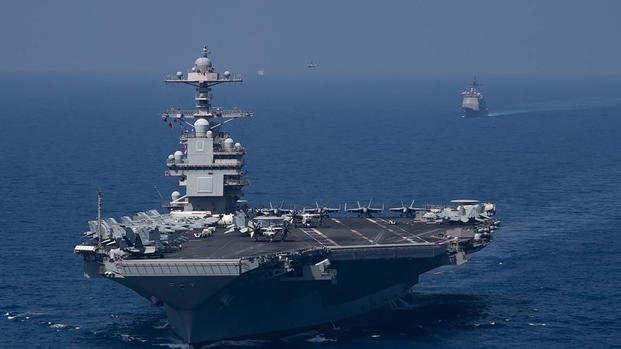WASHINGTON — President Donald Trump directed the world’s largest aircraft carrier into the Caribbean Sea on Friday in a major escalation of his drug war.
The USS Gerald R. Ford, one of a new class of nuclear-powered supercarriers, is being deployed from the Mediterranean to the waters south of the United States along with three additional destroyers.
The redirection of a carrier is a significant military move and often suggests larger operations to come.
The Pentagon said the deployment was part of the administration’s objective to “counter narco-terrorism in defense of the Homeland” and to dismantle the drug cartels.
“The enhanced U.S. force presence in the USSOUTHCOM AOR will bolster U.S. capacity to detect, monitor, and disrupt illicit actors and activities that compromise the safety and prosperity of the United States homeland and our security in the Western Hemisphere,” Pentagon spokesman Sean Parnell said in a post on social media.
“These forces will enhance and augment existing capabilities to disrupt narcotics trafficking,” he noted.
The buildup in forces comes after a series of additional strikes against vessels the administration claims are carrying drugs. Three vessels were hit this week, bringing the number of targets destroyed to 10, with eight strikes in the Caribbean and two in the Eastern Pacific.
At least 43 people have been killed in the strikes, according to the Trump administration.
The heavy buildup of forces has raised questions about the president’s intentions.
The Trump administration says it is trying to disrupt the flow of drugs into the United States. Many, however, see the strikes as a warning to Venezuelan strongman Nicolás Maduro, who faces criminal charges in the United States and has a $50 million reward for information that leads to his capture.
Maduro, who is accused of stealing last year’s presidential election, responded with his own show of force, sending soldiers to the coastline for defensive exercises.
Also being questioned are the legality of the strikes. The White House hasn’t given a direct answer to why those on the boats are being killed instead of captured and charged with drug trafficking. Two survivors of a recent strike were back to Colombia and Ecuador, respectively, instead of facing criminal charges.
President Donald Trump claims his drug war is a national security issue.
“Under the Trump administration, we’re finally treating the cartels as the core national security threat that they really are,” he said Thursday at the White House. “Our objective is to eliminate it.”
“We’re just gonna kill people that are bringing drugs into our country. We’re going to kill them. They’re going to be, like, dead.”
The pace of the American strikes has increased, as has their scope. This past week, the action expanded beyond the Caribbean into the Pacific Ocean.
Trump has indicated a land operation will be next.
“The land is going to be next,” he said Thursday without offering a specific location. “You’ll be seeing that soon.”
Any land operation would likely be a missile strike and not American boots on the ground. The Air Force flew two B-1 bombers off the coast of Venezuela, The Wall Street Journal reported, but the planes stayed in international airspace.
The bombers could be used to knock out narcotic production and distribution facilities. Trump denied the flights took place when he was asked about them.
“I wouldn’t be surprised if we don’t see limited land operations focused on Maduro before the first week of November is out,” said Professor Evan Ellis of the U.S. Army War College Strategic Studies Institute.
“Although I don’t expect the major U.S. operation against Maduro until the end of November or early December,” added Ellis, a former State Department official who worked in the region.
It will take the Ford and the rest of the carrier group several days to make the voyage from Mediterranean Sea to the Caribbean.
They will join 4,500 U.S. personnel — Marines and Navy — a cruiser, several destroyers and a Los Angeles-class attack submarine already in the region.
It remains unclear what was on the boats the administration has targeted. The Pentagon has provided no definitive proof there are drugs on board.
It’s also unclear just how much drug traffic into the U.S. the president is stopping. The majority of drugs arrive by land, being carried over the U.S.-Mexican border after arriving in Mexico via the Pacific Ocean. Drug traffic in the Caribbean typically ends up in Europe.
_____
©2025 Miami Herald. Visit at miamiherald.com. Distributed by Tribune Content Agency, LLC.











